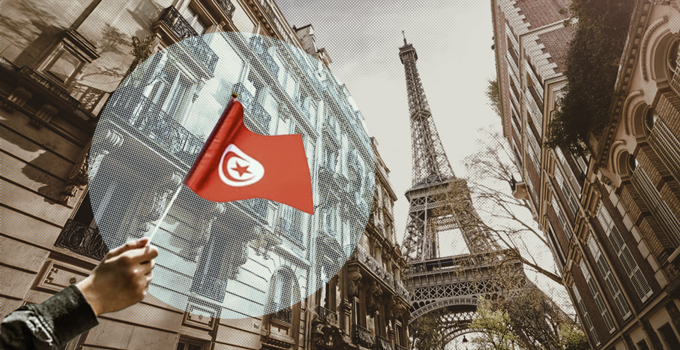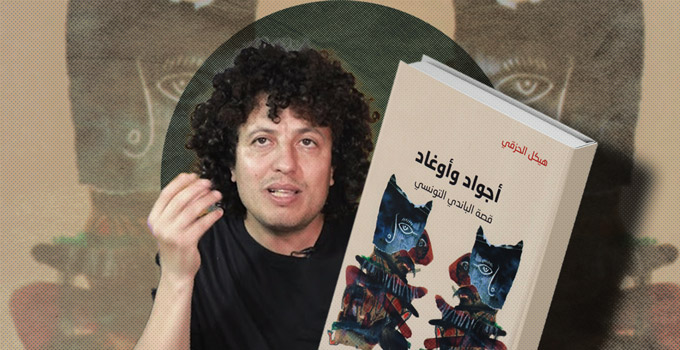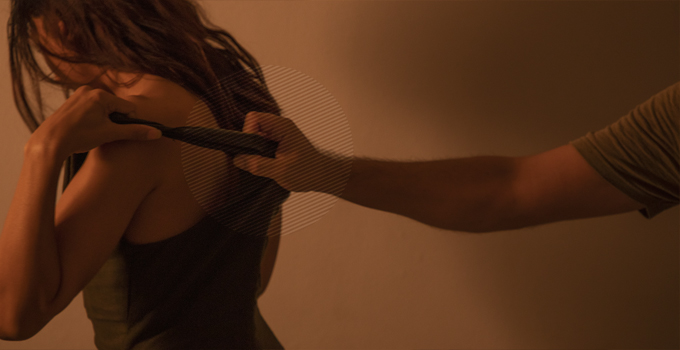On the evening of Sunday, September 26, 2022, nearly a thousand Douar Hicher residents gathered around activists campaigning for the socially excluded at the neighborhood’s entrance. What were their demands? Free medical cards for low-income individuals, financial aid, jobs, and equipment and medicine for the neighborhood clinic. One day later, the convoy of Minister of Social Affairs Malek Ezzahi showed up in Douar Hicher. A resident recounted that campaign coordinators had asked the minister for 500 schoolbags for students from low-income households. Evidently, the request didn’t go down easily for the minister, who simply repeated: “five hundred schoolbags?”
Along the road called Oued Ellil, the first turnoff gives way to a long street. Following this route, one arrives at the hilltop neighborhood of Douar Hicher, home to 87 thousand Tunisians. The long street, Rue des Martyrs, is also referred to by locals as Street 55 in reference to the bus line that serves the governorate of Manouba.
A MOVEMENT BORN IN PAIN
Road 55 is at the heart of residents’ grievances in Douar Hicher, where locals are eager to break the isolation which surrounds the neighborhood. They demand buses and collective taxis to facilitate travel to the city center and neighboring areas, as well as equipment for the local dispensary and real solutions for unemployment. The collective named for those it represents—« the socially excluded »—has been active in Douar Hicher since December 17, 2018, and is a direct product of these grievances.

The collective has initiated a series of actions. In March 2019, it threatened to hold a general strike in protest of the government’s failure to uphold an agreement concluded with the governorate of Manouba, the regional authority which encompasses Douar Hicher. In November 2020, motivated by the same issue, the group blocked the Route Nationale 7. In April 2021, during the month of Ramadan, which was marked by particularly high inflation, the movement organized a collective iftar in front of the municipality headquarters. In November of the same year, collective members and residents organized a march from the municipality to governorate headquarters. Their objective: to urge the government to keep its promises and reiterate their main demands, including free medical cards, social assistance for the neighborhood’s most impoverished families, licenses for collective taxis and for tobacco stores…
The most recent initiatives took place in September 2022. Campaign Coordinator Ali Bouzouzia worked to carry out activities on a weekly basis, as social contestation threatened to spread to neighboring areas.
As sociologist Jihad Haj Salem explained to Nawaat, “Douar Hicher faces real challenges, especially stigmatization. In early 2011, a group of residents asked the authorities to change the name of their neighborhood to free them from its curse once and for all. However, administrative complications relating to the replacement of ID cards prevented fulfillment of their request.”
According to Haj Salem, Douar Hicher also suffers from a particularly elevated unemployment rate and high population density (around 8,000 inhabitants per square kilometer). And, although the neighborhood benefited from a flood prevention project in 2015, general infrastructure is run-down.
Forty-year-old Raafat, an unemployed resident of Douar Hicher, is furious: “Before losing my job, I was a mechanic. I actively looked for work outside the neighborhood. But as soon as I showed my ID card with an address in Douar Hicher, the doors closed on me. I lost all hope. My wife and I agreed to divorce to ensure the minimum of food and shelter, with each one living under the roof of our parents. I have a son in high school and haven’t been able to buy his books yet. All I’m asking for is work and a free medical card. I have been asking for one since 2018, but still have not received any response.”
STATE “POISONS” THE NEIGHBORHOOD
In 1792, Hammouda Pacha al-Husseini, the fifth bey of Tunisia, built the “Sabil de Hammouda Pacha,” a hydraulic system linking the capital to the suburbs of Manouba. Today, remains of the structure can still be seen near the entrance to the Al-Qassab Hospital. This water station also served as a recreation center, housing a café, two water basins and a well that supplied locals with drinking water. A mosque provided space for worshipers from the surrounding area to gather. These structures did not withstand the test of time. All that remains are a few stones and commemorative inscription from time the station was erected.
Nearly two and a half centuries later, the “Sabil de Hammouda Pacha” appears to be the only development project undertaken in the part of Manouba consisting primarily of marginalized neighborhoods which emerged in the early 1970s, like Douar Hicher. Ahmed, a local resident, tells Nawaat, “By ignoring Douar Hicher, the state is poisoning the neighborhood and the minds of children here from an early age. What we really need are trees and green spaces for a breath of oxygen in this stifling atmosphere. How is it possible that the state can neglect children to this extent?”

With bitterness in his voice, Ahmed evokes the neighborhood’s only park, which is in pitiful condition. “This is the only space where families are supposed to be able to go and spend time with their children. But the park has become a garbage dump. It’s crawling with stray dogs.“ Ahmed is interrupted by the cheerful exclamation of several children: “Give us back the park! Give us back the park!” Having spotted the photographer, the children imagine that an official has arrived, that their only green space is soon to be renovated.
ABSENCE OF PUBLIC SERVICES
The same state of neglect is characteristic of the neighborhood’s sole healthcare center, where a half-demolished fence reveals a pile of garbage in the courtyard.
“Our demands are simple, but the authorities have ignored us,” says Majed Mannai, an activist with “the socially excluded” campaign. “We have the right to an adequate clinic that provides basic care and medicine. We demand a space where families and children can have fun. We want two bus lines and a collective taxi to end our isolation, broaden our horizons, facilitate the commute to work and reduce the temptation of irregular migration across the Mediterranean.”

The youth of Douar Hicher between the ages of 15 to 29 face an unemployment rate of 21.22% and an illiteracy rate of 20.46%, according to a 2014 study conducted by the National Youth Observatory.
Adel, a 40-year-old man with an amputated right leg, confesses to Nawaat that he cannot read. “When I was young, I did not go to school. My father didn’t register me because he had barely enough to feed us,” he recounts.
“I am married and have five children. The state gives me 230 dinars a month, and my rent is 250 dinars a month. I don’t want my five children to be illiterate like their father, but as it is now, I cannot afford to buy them books,” Adel tells us.
Fifty-something Ahmed (a pseudonym) quickly interrupts him: “Buying books is a secondary issue, especially for a family of six. The neighborhood has many problems, but unemployment and marginalization are the most significant. Children in the neighborhood have no green space or sports field where they can play like kids their age. They are forced to wait until nightfall once traffic calms down to go out and play in the streets.”
“THE SPARK WILL BE LIT HERE”
In 2018, the residents of Douar Hicher delegated a group to advocate on their behalf before the regional authorities of the Manouba governorate as well as the central government, then under the administration of Youssef Chahed. Majed Mannai tells Nawaat campaign members submitted a case file containing proposed solutions to ensure better connectivity between Douar Hicher and the capital as well as the Sliman Kahia metro station. This plan required that licenses be granted to collective taxis and also that a new transport line be set up to head eastward, the main direction residents travel for work. “We proposed solutions for this issue four years ago, but we have had no response from the regional or central authorities,” he says.
Due to the lack of collective taxis, Mannai commutes to work on foot every day, a trip that takes him an hour. Unlicensed taxis serve to some extent to bridge the gap in transportation. Bus drivers of lines 55 and 56 let passengers off at the entrance to Douar Hicher rather than the main bus station at the end of the end of Avenue des Martyrs in the heart of the neighborhood. Over the span of a week, Nawaat attempted to get a response from the Manouba governorate regarding these issues. To no end.

In an effort to calm Douar Hicher residents, the campaign’s coordinators have granted the government a short period of time to respond to their demands. As Mannai tells us, “I think that Ali Bouzouzia, who was active within the General Union of Tunisian Students, did a great service to the state when he was designated to communicate the demands of Douar Hicher residents to the relevant authorities. Upon his request, the campaign’s coordination team surveyed the neighborhood’s grievances. This was possible thanks to the community’s trust. But their patience has limits.”
Douar Hicher has drawn the interest of many sociologists over the years, especially following the terrorism-related incidents that began in 2012. Their aim has generally been to understand the phenomenon of “violent extremism” and identify their causes in a context characterized by arrests and searches that targeted jihadist movements in the region until 2016.
Inadequate public services plus social challenges provide fertile ground for extremism. In a situation of soaring inflation, deteriorating living conditions, and the absence of any reassurance for the future, the majority of Tunisian cities appear vulnerable to the threat of a social explosion. Tensions are likely to run high throughout the winter of 2023, with Douar Hicher residents predicting that the spark of the “revolution of the hungry” will go off in their neighborhood.





iThere are no comments
Add yours